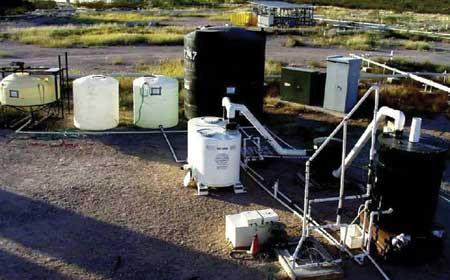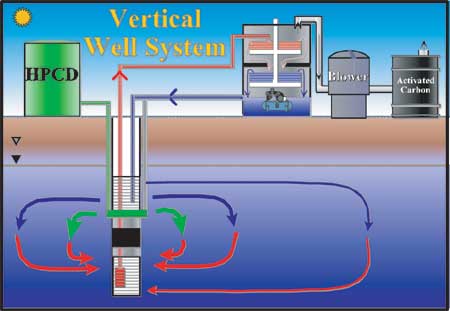Remediating Soil and Groundwater Contamination
Tools and strategies that are making a difference
2003
Arizona Agricultural Experiment Station Research Report
![]()
Written by
Susan McGinley
Chemical compounds that contaminate soil may also pollute groundwater,
hemical compounds that contaminate causing health and environmental problems.
Years after a hazardous substance has been taken off the market, it may
persist in soil at the primary zone of contamination and also in plumes
that spread out, making it difficult to clean up or remediate.
Mark Brusseau, an environmental scientist in the Department of Soil,
Water and Environmental Science at the University of Arizona, has spent
about 15 years researching and designing systems for reducing or eliminating
contaminants from the soil. He has assisted in devising methods for cleaning
up various Superfund sites, including one at Tucson International Airport
(TIA).
Organic soil contaminants such as trichloroethylene or TCE—once
used to clean aerospace electrical components at TIA—persist because
they get caught in pores between sediment grains in the soil. “Once
trapped, they’re very hard to remove,” Brusseau says. “A
little bit can contaminate a very large amount of groundwater and serve as a very long-term problem.” TCE is a suspected human carcinogen.
Every project is a collaborative effort involving university scientists,
industry managers and government agency officials. Brusseau’s role
is to analyze the character of each spill. He identifies the specific
processes that control the movement or remediation of the contaminants
involved. Then he researches and develops remediation technologies that
are feasible and suitable for each site. Industries and government agencies
adopt the strategies that are most cost-effective and thorough in removing
the contaminant.
Various organic and inorganic pollutants require different cleanup technologies.
One treatment option is bioremediation, the process of using plants or
microorganisms to degrade contaminants. It works well on gasoline leaks
from storage tanks, but chlorinated solvents such as trichloroethylene
(TCE) do not respond as effectively to bioremediation. Some of Brusseau’s
work has focused on TCE and similar compounds that require other approaches.
He and his colleagues, including students, start each decontamination project at the source zone, the area where the contamination has entered the soil subsurface.
“This is usually where there was a break in a pipe or a tank—a
leak,” Brusseau says. “With TCE the actual liquid gets trapped
in that vicinity of the spill location. It’s a highly concentrated
contaminant mass that is immiscible, meaning it doesn’t mix with
water. When it reaches the soil vadose zone, an aerated area above the
groundwater, it can evaporate partly into the air and spread eventually
into the groundwater plume.”
To decontaminate a site, both the source zone and the plume need to be removed. To figure out what works best for each problem, Brusseau uses a combination of field tests, bench-scale laboratory studies and computer modeling systems that show how TCE and other chemicals would behave at a site.
Right now he and his group are looking at an enhanced pump-and-treat
method, where a remediating agent is pumped into the source zone to attach
chemically to the contaminant, flushed back up to the surface, and then
treated and either disposed of or stored.
With enhanced flushing, the scientists create a solution using a reagent that mixes with water, and pump it down to the contaminant in the source zone.
“The idea is the same as using detergent to lift dirt from clothes,” Brusseau says. “We are essentially taking a detergent, mixing it with water, injecting it into the source zone and pumping it back up to bring out contaminants.” Contaminants that lend themselves to this type of treatment are ones whose water solubility is low; they transfer into the reagent solution in a greater amount and more quickly than they would if mixed with water alone. The detergent Brusseau is looking at involves sugar-based compounds called cyclodextrins.

This is an example of an actual cyclodextrin vertical flushing system that was used at a contaminated site.
“The community might be concerned about what you’re putting in the site,” Brusseau says. “Our sugar molecule is derived from cornstarch. We hope people will be more comfortable about having this used to clean up a site in their communities.”
Shaped like a lampshade, the cyclodextrin molecule has a cavity in the
middle that has a low polarity, while the outside has a high polarity.
Since water is polar, the cyclodextrin mixes well with it. When pumped
down to the contaminant, the cyclodextrin molecules engulf the TCE, pulling
it inside, away from the water it can’t mix with. When the cylodextrin
molecules are flushed to the surface, they carry out the TCE as their
cargo.
“I first became aware of this cyclodextrin compound when I served
as a judge for a high school science fair,” Brusseau says. “I
got interested in the compound and found it was used for other applications
in analytical chemistry and pharmacy studies. It is included in fabric
softeners as a delivery agent.” At the UA he has tested it in bench-
scale investigations in the lab and then tried pilot-scale demonstrations
at four actual field sites around the country, including one at TIA.
Another compound Brusseau and his team are testing is potassium permanganate,
which operates in a completely different way. It oxidizes and breaks down
carbon compounds right where they are in the ground. A widely available
water treatment reagent, potassium permanganate has only recently been
tried in remediating soil contaminants.
“We dissolve the potassium permanganate in water, put it in the source zone and it degrades or destroys the molecules. It’s like bioremediation, but using a chemical reagent rather than microorganisms,” he says. “The toxic compounds break down in place so you don’t have to bring them to the surface. The contaminant is no longer a hazard when it’s broken down.” The process differs from bioremediation in that it uses a chemical instead of a biological molecule to do the job. Brusseau and his colleagues tested this in the laboratory and have recently tested a pilot- scale field implementation of it.
Potassium permanganate is cheaper to use than the other methods, but its adoption still depends on how effective it is in each situation.
Brusseau enjoys applying basic science to real-world problems in collaboration with cooperating industries and government agencies. He says the best way to clean up contaminated sites is to combine the efforts of scientists at research institutions, consultants working in the field, managers of industries where the actual contaminated sites are located, and officials from the regulatory agencies overseeing the cleanup. Working together they can address the contamination and include the input of community members who may have concerns about the contamination and the method selected for reducing it.
“This brings the best knowledge and skills to apply to real sites, to help improve remedial actions,” Brusseau maintains. “TIA is a good example of this collaboration, where the UA, Raytheon, the EPA and U.S. Air Force all worked together on enhancing the basic remediation system. We’re trying to understand how chemicals move in the ground and to apply that knowledge to contaminated sites to improve remediation and ultimately prevent future contamination.”

This schematic shows the flow of the reagent cyclodextrin (the green tank marked “HPCD”) that is mixed with water, pumped to the source zone where it attaches chemically to the contaminant, and is flushed to the surface together with the contaminant.
CONTACT:
Mark Brusseau
(520) 621-3244
brusseau@ag.arizona.edu
www.u.arizona.edu/~brusseau
Return to the Title Page
Return to the Table of Contacts
The University of Arizona is an Equal Opportunity/Affirmative
Action Employer. Any products, services, or organizations that are mentioned,
shown, or indirectly implied in this publication do not imply endorsement
by the University of Arizona.
Published January 2004
Return to College publication list